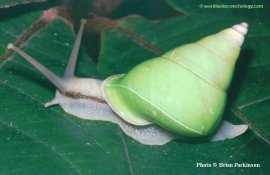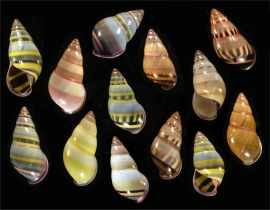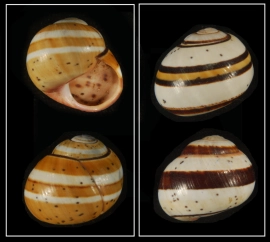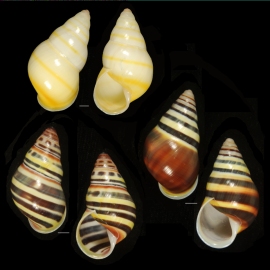[Adapted from an article that I co-authored entitled, “Isolation of Evolution of the Amphidromus in Nusa Tenggara” in American Conchologist magazine]

The almost 2 inch endemic Manus Island Green Tree Snail, Papustyla pulcherrima, is one of only a handful of tropical land snails that have a naturally green shell color. Photo by and courtesy of Brian Parkinson from worldwideconchology.com
The tropical biosphere is inhabited by animals of far greater color than any other zoogeographical zone on Earth. The Phylum Mollusca, and in particular the terrestrial mollusks, the land snails, develop shells that have some of the greatest diversity of color and pattern among all living organisms.
The often brilliant coloration and bold patterns attracted ancient societies who used the shells for ornamentation purposes. Today, naturalists with a bent on conchology are still amassing collections of these brilliantly colored snails for aesthetic reasons, but also for scientific study.
The question of why these molluscan species have developed a multitude of colors and patterns can be best understood through the foundations of evolutionary science.

Amphidromus adamsii, an extremely varied 25mm (± 1 inch) land snail species that may exhibit the ultimate in intra-population variability. Photo: Richard L. Goldberg (copyright 2009) from BiologySource 11 by L. Sandner, et. al, published by Pearson Publishing.
Land snails can develop shells with myriad colors forms within one population (intra-population variability), or may vary from the norm only in separated populations (inter-population variability). Occasionally a species can exhibit both phenomena. The Darwinian concept of natural selection can best be used to explain why a snail species can vary locally or over its entire range.

Forms of the half inch-size Fly-Speckled Polymita, Polymita muscarum, a species that exhibits inter-population variability throughout its geographical range in Oriente Province, Cuba. Left - A color form found at Loma de Calixto; Right - shells from Port of Vita. The Port of Vita form also exhibits considerable variation within the population, or intra-population variability. Photo: Richard L. Goldberg.
The external appearance of a shell — color and pattern, for instance — are likely to be influenced by natural selection when determining the genetic make up of a snail. Extreme color polymorphism in a population perhaps indicates that looking different from your neighbor is advantageous, making it more difficult for predators to develop a search image, such as color and contrast, to locate their prey. The unique color form can then spread rapidly in a population.

Amphidromus laevus from Timor-Leste. An example of frequency dependent selection where the typical dark banded pattern is occasionally replaced with a unicolored shell. Photo: Richard L. Goldberg.
This phenomenon, known as frequency dependent selection, may explain why some intra-populations of snails in the genus Amphidromus from eastern Indonesia often have unpatterned or strikingly different colored shells mixed in among the predominantly multi-colored or strongly patterned shells. Natural selection is typically considered to favor one form over another, thereby shifting the bell curve, yet frequency dependent selection flattens that bell curve and spreads it out.

An example of genetic drift. Left - Amphidromus wetaranus from Wetar Island, Indonesia. Right - A form of the same species from a small satellite island off Wetar Island. The red central band found on all specimens of the satellite island form is never found on the Wetar Island form. Photo: Richard L. Goldberg.
One explanation for inter-population variability may be a phenomenon called genetic drift. To illustrate this, let’s say a population gets split in two, one on island A, and one on island B. Both populations might start off identical, with chances at 50/50 for a particular trait. It is unlikely that the offspring will be 50/50. They may be 47/53, and the subsequent generation may be 43/57. Over many generations, the percentages will fluctuate up and down at random, and they can end up being very different from where they started. Yet, in the real world, a new mutation doesn’t start at 50/50. It might be only 1/10,000 or 1/100,000. By chance it can have more surviving offspring than average, and slowly increase in the population. Smaller populations will drift faster than large populations. But, if by chance that first mutant does not have any surviving offspring, that trait disappears. This is a more likely scenario. So, genetic drift tends to eliminate variation within a population and increases differences between populations. Over a period of time, the populations from islands A and B will end up looking very different.

These shells of Amphidromus columellaris from the Tanimbar Islands, Maluku Region, Indonesia show little variation within the population. Could that balance be tipped by the founder effect? Photo: Richard L. Goldberg.
Inter-population variability might also be explained by the founder effect. The snails that colonize an island may represent only a small fraction of the parent population’s genetic diversity. If a rare mutant color form is mixed in among the new colony, a colony that was 1 in 1000 in the parent population, it may instantly be 1 in 10 in the new population. Given a brand new set of environmental influences, the population may evolve in whole new directions from its parent population.
Environmental factors such as the geology, climate, flora, fauna, and food are all suspected contributors to the rise of a unique shell appearance. To reduce the competition with other species which overlap in some aspect of their niches, a phenomenon called character displacement occurs. Shell, behavioral, anatomical or biochemical characters eventually deviate from the ancestral form to allow the species to survive with its neighbors. Character displacement might also manifest itself in the color, pattern, and even the form of the shell. Changes brought on by one, or a combination of, these biological concepts can eventually render an isolated population unable to interbreed with the parent population, producing a situation which makes speciation possible.Isolation is the key ingredient for a species to evolve, and natural barriers provide the necessary separation to allow speciation to take place. Whether the barrier is a series of mountain ridges separated by deep valleys, or islands separated by wide channels as in the case of some species of Indonesian Amphidromus, isolation allows a species to evolve independently from its ancestral form.
Though these concepts are often difficult to understand when evolutionary science is not your main focus, understanding that tropical snails do change and adapt to external factors and random influences is enough to appreciate just how diverse a snail species can be.
Leave a comment